The Voynich Manuscript: Full Circle

One of Nick Pelling’s blogs focused my attention on investigating the finer details of the VM, particularly on Folio 17v, where I was fascinated to find the concealed name of the artist. The hairs on top of the middle tuber spell L ? Vinci, Plate 1. Was I surprised to find that Leonardo had included his name as part of the drawing? No! Leonardo was known for his love of visual puns and rebuses (a pictorial puzzle), and for tricks, jokes and deceptions of all kinds.(I) (II)
It is said, one swallow does not make a summer, so it will take more than one set of hairs on a tuber that looks like the word L da Vinci, to convince skeptics that I may actually be correct in suggesting that Leonardo da Vinci wrote this manuscript. The astrological chart, Folio 70v, refers to Leonardo’s date of birth(III), the hatching on the drawings from Folio 84r indicate a left-handed artist(IV) and the letter on the last page is addressed to someone called Vinci(V). I therefore examined other folios for the word Vinci. The VM pages from the Internet are generally either too dark or too light to make deciphering easy. I used two techniques in Photoshop to improve their quality, Auto Levels to lighten the background and if necessary Curves to darken or lighten the image. No additional enhancement techniques were used. Additional examples of the word Vinci were found incorporated in the roots and stems in the following Folios:
- Folio 46v – Plate 2
- Folio 20r – Plate 3
- Folio 41r – Plate 4
- Folio 2r – Plate 5
- Folio 99v – Plate 6
- Folio 56v – Plate 7
- Folio 66v – Plate 8
There are too many Folios to check them all for the Vinci name. More examples can probably be found.








A small segment of Folio 86v, Plate 9, shows a castle with swallowtail battlements and a drawing of a town or village above it. By lightening the image of this segment of Folio 86v, I observed that the word Vinci was written next to the drawing of the town that included houses, a church steeple (very faint) and the tower of a castle. I therefore speculated that this drawing represents the town of Vinci whose curved walls resemble those in the drawing. Vinci lies on the southern slopes of the Montalbano Mountain and is close to Leonardo’s place of birth. The medieval Conti Guidi Castle, known as the castle of the ship because of its curved walls, dominates the town. The church of Santa Croce, where Leonardo was probably baptized, is part of the castle complex. Plate 10 presents a comparison of this VM drawing and a sketch of the Conti Guidi Castle and the Santa Croce Church based on a photograph from the book, Leonardo da Vinci the Renaissance Man(VI). This comparison is at best superficial, but it does show that the location of the church with respect to the castle is approximately the same in both the drawing and the sketch.


The Emperor’s Castle (started 1240) in the town of Prato, eleven miles from Vinci, has swallowtail battlements like the castle in Folio 86v, Plate 11. It has a square plan with square towers at the four corners and the center of each side. The top of the castle is crowned with swallowtail or Ghibelline battlements that are not typically found in Tuscany. This type of battlement is usually found on castles from Milan to Venice in Northern Italy. The castle in Folio 86v may or may not represent the Emperor’s Castle but it is reasonable to assume that Leonardo visited Prado during his youth and was therefore aware that not all castles had rectangular shaped battlements.
Having found examples of the word Vinci in several of the VM’s folios led me to wondering whether in later life Leonardo incorporated his name in some of his sketches. You may wonder why I bothered to look, considering how carefully his manuscripts have been examined. The following plates give examples that show that he continued this practice in some of his later drawings:
- Plate 12. Old Man, part of water studies, Windsor, 12579r.
- Plate 13. The sheet with five heads, Windsor, 2495r.
- Plate 14. A study for the Trivulzio equestrian monument 1508 - 11. Windsor, 12355r.
- Plate 15. A preliminary sketch for the 'Adoration of the Magi', Louvre, Paris.
- Plate 16. Angel of the Annunciation, Windsor.
- Plate 17. Drapery study for the right sleeve of Saint Peter. Windsor
- Plate 18. The baby from Madonna and a fruit plate, Louvre, Paris.
Artists in the 15th century were regarded as artisans and they rarely signed their own work. Leonardo had a strong sense of self worth and was probably reluctant to leave his work without some form of identification. He had been accustomed to hiding his name in his drawings during his youth so he appears to have continued this practice in later life, mainly on drawings involving people.

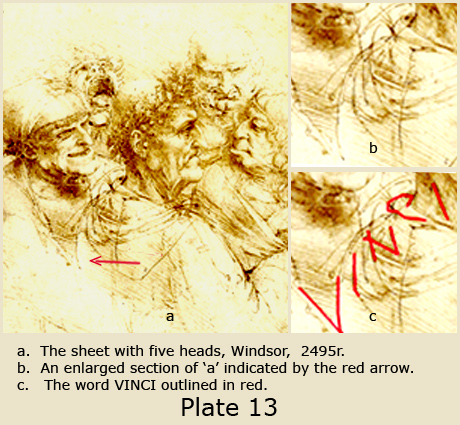
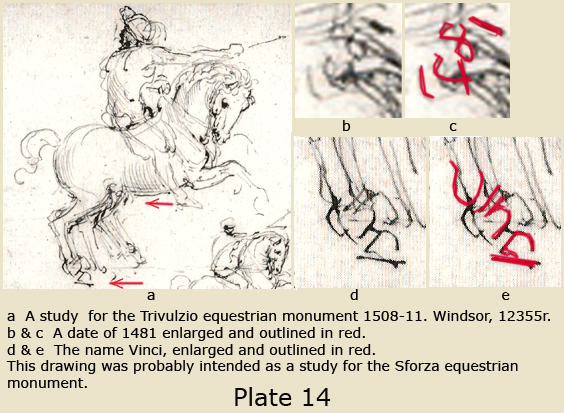
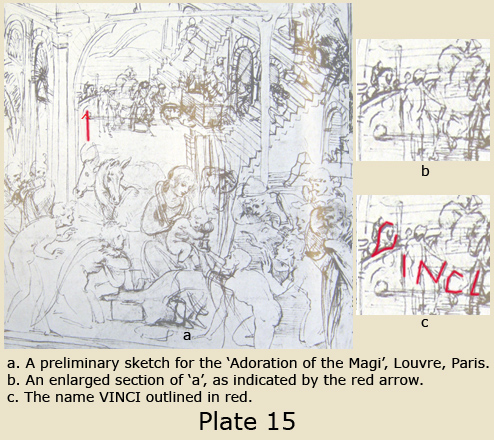

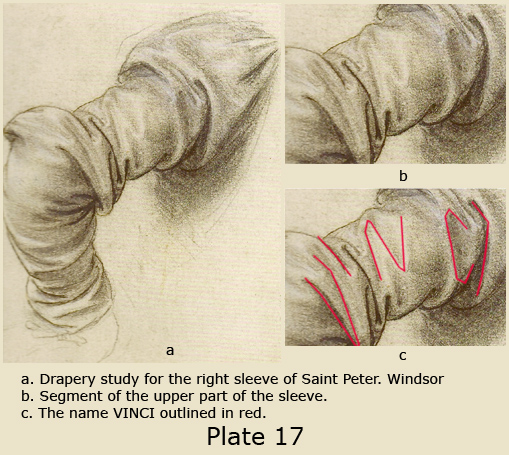

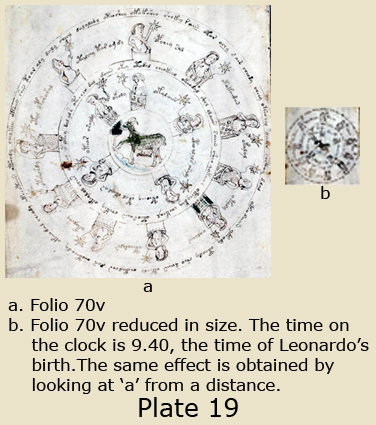
I I thought that I had discovered all there was to know about Folio 70v, the folio I consider to represent Leonardo’s personal astrological chart. An amazing feature of this folio, Plate 19, is the face of a clock that emerges when the size of the image is decreased or the drawing is viewed from a distance. In my first document, the Voynich Manuscript and Leonardo da Vinci, I postulated that the position of the little lady with the baby, sitting in the tub at the 10 o’clock position on the diagram, probably represented the time of his birth. Although the outer ring of the drawing has only ten little ladies, a clock face has twelve, I have the impression that Leonardo intended to use it to record the exact time of his birth, namely 9.40 pm. Leonardo’s grandfather recorded that he was born at 3 hours after sunset, which on that day was at 6.40 pm, making his time of birth 3 hours later or 9.40 pm. I never expected such a graphic representation of the time of his birth, 9.40 pm, as shown by Plate 19, particularly not from a young boy. One of the first early records of a minute hand on a clock is in the Fremersdorf collection that dates back to about 1560. It is possible to estimate intervals within an hour with a one handed clock. By designing a clock with two hands Leonardo demonstrated his very practical, creative genius that must have manifested itself at an early age. Perhaps designing a clock with two hands should be added to his long list of inventions.
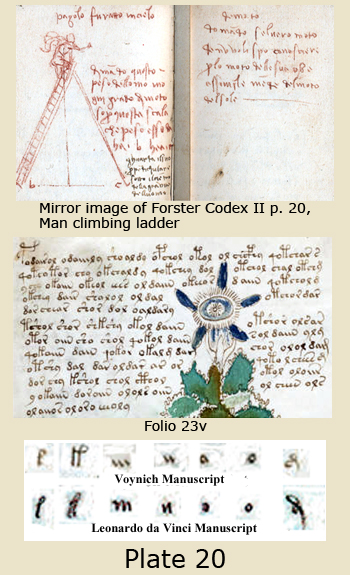
Plate 20 shows a mirror image of an example of Leonardo’s handwriting taken from Forster Codex II (~ late 1480 and 1494) and a sample from Folio 23v. Superficially Leonardo’s writing and the VM script are similar in appearance, in spite of the VM using its own set of symbols. Plate 21 also shows that some letters, l, tl, a, m, n, o and &, all taken from the above examples, are similar. This is a comparison between a child’s writing with that of a mature man. As Leonardo matured, his writing became less ornate and lost the squiggles and flourishes of his younger days. Compare the ‘m’s’ as an example, the flourish at the end of this letter is absent in his later writing.

I I was surprised to find a symbol similar to a modern ampersand in both the VM and in Leonardo’s writing. He used this symbol as an abbreviation for the Italian word ‘di’ (translates as ‘of a’)(VII) and wrote the symbol in his mirror image writing beginning on the right with the bottom loop of the ’d’ and finishing on the left with the ‘i’. The VM symbol also begins with the bottom loop of the ‘d’ on the left and finishes with the ‘i’ on the right. The modern ampersand is written in the reverse direction, Figure I.
Some people have questioned whether a left-handed artist like Leonardo could have written the VM. The manuscript is written from left to right by someone using their right hand, while a left handed individual made the drawings. During the Middle Ages left-handed people were called southpaws and were often accused of practicing witchcraft. The Devil himself was considered to be a leftie. People writing from left to right, when using their left hand, tend to smudge the ink as their hand moves across the page. Children, who were born left-handed, were forced to write with their right hand, a practice that continued until the beginning of the 20th century. My father, born in 1889 and educated at the Manchester Grammar School and University, UK, was left-handed but made to change. For his entire life, he wrote with his right hand in a copper plate script, even though he could write equally well with his left hand. This practice changed in the 20th century, my eldest brother, born in 1924, was allowed to write with his left hand. Both Leonardo and Michelangelo were lefties, who as children were probably made to write right-handed. Michelangelo, in later life, went one step further and trained himself to draw with his right hand. Alessandro Vezzosi states that Leonardo was generally but not exclusively left-handed. It is quite conceivable that, as a child, he wrote the VM with his right hand.
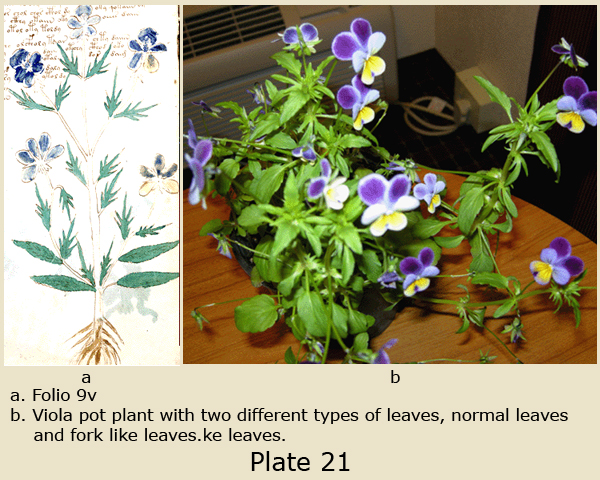
Anyone who views the VM’s botanical drawings for the first time may be confused by their eccentric characteristics. Some of the plants are exaggerated with respect to size and many have whimsical roots. I questioned whether a viola plant, like the one in folio 9v, with two very different types of leaves, actually existed. My doubts were dispelled when by chance I found a single viola plant in a pot on a flea market table in Northern California. This plant is the double of the VM drawing, it has forklike leaves in addition to normal ones, Plate 21. In the Codex Atlanticus, Leonardo mentions that he drew ‘many flowers from nature’. Antonio Baldacci states that ‘these drawings were undoubtedly done in his youth, but are lost today… From his twentieth year on, the most diversified species of plants and their parts fascinated Leonardo’s mind. … The drawings of complete specimens made in his youth, from which he obtained his knowledge of the habits of various species chosen for artistic purposes at that time, were followed by splendid examples in which art is combined with scientific aims, …’(VIII). Were Leonardo’s drawings actually lost or are they part of the VM?

If the reader of this article still has doubts as to whether Leonardo was the author of this manuscript they should take a look at Plate 22, a comparison between the middle drawing from Folio 85v and a drawing by Leonardo called Embroidery with the words ‘Accademia Leonardi Vinci’ in the center. The latter drawing appears to be an adaptation of the drawing from the Voynich Manuscript.
The history of the VM from the time it came into the possession of the Holy Roman Emperor, Rudolph II or Jacobus de Tepenec ~1600, until discovered by Wilfred Voynich in a monastery outside Rome in 1912, is reasonably well understood(IX). This unimposing little book must have had some form of provenance that preserved it for the ~150 years prior to the early 17th century when it was purchased by Rudolph II. Since Roger Bacon is no longer the presumed author, we may regard the involvement of either Edward Kelly or John Dee in its sale to Rudolph II as a red herring. However as one of Leonardo’s notebooks, the provenance of the VM is established. A chain of custody from Leonardo via Rudolph II to Jacobus de Tepenec may be as follows:
- Leonardo, who kept his notebooks with him until the time of his death in France in 1519, bequeathed them to his friend and pupil, Francesco Melzi.
- Melzi kept them at his home in Northern Italy until his death in 1570.
- His son, who had no use for the books, sold them off to various people including the sculptor to the Spanish throne, Pompeo Leoni.
- Leoni sorted the papers and arranged them according to his own taste. Some of the intact notebooks he sold to Spain and after his death in 1608 the rest went Count Galeazzo Arconati who donated them to Milan(X).
- Between 1599 and 1601, Rudolph II through his ambassador in Spain, Johann Khevenhüller, tried to procure two paintings from Pompeo Leoni(XI) and he may have obtained the VM and perhaps the Forster Codices at this time.
Rudolph II (1552-1612), who spent eight years of his youth at the Spanish court of his maternal uncle Phillip II, returned to Vienna in 1571 and became Holy Roman Emperor in 1590. He was the patron of some of the best contemporary artists and spared no expense in acquiring great past masterworks of art and an extensive library devoted to alchemy and the occult. His collection at the time was the most impressive in Europe.
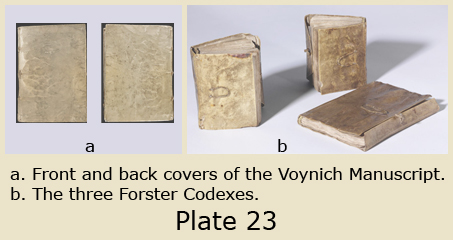
Three of Leonardo’s small, brown, parchment bound, notebooks, Codex Forster I, II and III, Plate 23, are currently in the Victoria and Albert Museum in London. They were purchased by Lord Lytton in Vienna around 1850 and sold to John Forster, who in turn bequeathed them to the V & A Museum in 1876. After Rudolph’s death in 1612, most of his collection was packed into wooden crates and moved from Prague to Vienna. Was the history of Codex Forster I, II and III such that after Leonardo’s death they passed through the hands of Melzi to Pompeo Leoni to Rudolph II to Vienna where they were finally purchased over two centuries later by Lord Lytton? Did the VM have a similar history except that it passed after the death of Rudolph II, in payment for a debt (?), to Jacobus de Tepenec, the director of Rudolph’s botanical gardens. René Zandbergen(XII) offers a very comprehensive discussion of the history of the VM, from its possible inclusion in the library of Rudolph II, until discovered by Wilfred Voynich.in 1912.
If Leonardo wrote the VM, he probably began when he was a child. The presence of the Vinci name does not preclude other members of his family, his uncle Francesco for example, from being the author or original owner of the manuscript. Leonardo was born in 1452, making it unlikely that he began writing in the VM much before 1460. The 14C analysis of four pages of the VM, gave a mean 14C date of 1421 with a 95% probability range of 1404-1439. A majority of laboratories use the average counting error to determine the standard deviation of the reported age of the sample and do not take into account other errors that may occur during sample handling and preparation. Several experts recommend that a laboratory supply a laboratory error multiplier with their results to account for all errors in the reproducibility in their reported radiocarbon dates(XIII). The University of Oxford group appears to use a minimum 1SD standard value, +/- 50 BP years, when reporting their 14C results. This would make a young Leonardo a viable candidate as the writer of the VM.
Radiocarbon dating measures the 14C /12C ratio and not the age of the sample. Because the atmospheric level of 14C is not strictly constant with time, the determination of sample age requires the extrapolation of the sample age range from a 14C tree ring calibration curve. Dendrochronology is based on the assumption that a tree produces one annular ring per year and the 14C measurement of the wood within that ring represents the level of decay of 14C, from the time the wood was grown, to the present, defined as 1950. This appears to be a simple comparison to make, however the lack of precision in a sample measurement also applies to the 14C measurement of the tree ring sample. This results in an age range rather than an absolute value for the tree ring measurement that in turn requires a calibration curve to evaluate. 14C measurement on multiple trees reduces this problem. A two dimensional, decadal, probability curve is used to estimate the range within which the true age of the sample lies. Until science develops a better method for determining the true age of antique artifacts of biological origin, 14C dating provides the best information for estimating the approximate age of an article like the Voynich Manuscript.
As far as I am aware, the University of Arizona has not yet published their results and so no details related to the precision or the bias of their measurements with respect to the 2004 decadal terrestrial calibration curve is available. The range, 1404 –1439, represents the 95% probability of including the dates the animals used to make the parchment died, not the date that the VM was first written in. I do not know whether the VM was always the intact book we know today, or if it was made from individual pages or quires later bound together into a book.
I have come full circle since writing of my first acticle on the VM about 10 years ago. I suggest that Leonardo da Vinci be considered a likely author of this manuscript. The inclusion of the Vinci name in some of the drawings of botanical plants cannot be a coincidence, nor the fact that Leonardo continued this practice in some of his later authentic drawings. The question of the difference in the 14C data and the time Leonardo began the manuscript needs to be resolved.
I dedicate this article to the memory of my left-handed father, Prof. Henry Stephen OBE, D.Sc. FRIC, a great man and an accomplished organic chemist with an organic chemical reaction named after him. He received the OBE for identifying mustard gas, the poisonous gas the Germans used on the British and American troops during World War I.
Addendum: Since writing this article I have come across additional information. My father was not the only left-handed person of his generation made to write with his right hand. If you google the Wikipedia article on King George VI (1895-1952) of the UK, you will find the he was born left handed but forced to write with his right hand. I also found an interesting letter written by a bi-dexterous individual to a London newspaper, showing simultaneous writing with both hands, Plate 24(XIV). The interesting feature of this letter is the similarity in the right and left-handed script, possibly indicating that the brain records similar movements that it transmits to either hand, so the writing using the right hand looks very similar to writing with the left hand This should dispel any doubts that a left-handed Leonardo was incapable of writing the VM using his right hand and would account for the similarity in the VM writing and Leonardo’s mirror image writing.

- ↑ back Bramly, S., 1988, Leonardo The Artist and the Man, Penguin Books, London, p.112-113.
- ↑ back Vezzosi, A., 1997, Leonardo da Vinci, The Renaissance Man, New Horizons, Thames and Hudson, p.54.
- ↑ back Sherwood. E., The Voynich Maunscript and Leonardo da Vinci, http://www.edithsherwood.com/voynich_author_da_vinci/.
- ↑ back Sherwood, E. Voynich Manuscript: was the author left-handed?, http://www.edithsherwood.com/voynich_author/.
- ↑ back Sherwood, E., The Voynich Manuscript Decoded Part 2, http://www.edithsherwood.com/voynich_decoded_part2/.
- ↑ back Vezzosi, A., ibid p.16-17.
- ↑ back Richter, J.,P., 1970, The Notebooks of Leonardo da Vinci, vol I, Dover, New York, p.257.
- ↑ back Baldacci, A., 1956, in: Leonardo da Vinci, 1956, Reynald & Company, New York, p.450-1
- ↑ back Zandbergen, R., http://www.voynich.nu/.
- ↑ back Bramly, S., 1992, Leonardo the Artist and the Man, Penguin Books, p.418.
- ↑ back Helmstutler Di Doi, K., http://jhc.oxfordjournals.org/content/18/2/137.abstract.
- ↑ back Zandbergen, R., http://www.voynich.nu/history.html.
- ↑ back Stuiver, M. and Pearson, G.W. 1993, Radiocabon 35(1):1-25.
- ↑ back Hart, I.B., 1961, The World of Leonardo da Vinci, Viking Press, New York, p.142.